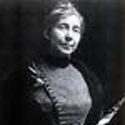

Sarah Wyman was born in Lowell, Massachusetts, but spent her girlhood in Baltimore, Maryland, with her cultured, wealthy Wyman relatives. When her family returned to Lowell, eleven-year-old Sarah was tutored at home and by all accounts developed a life-long passion for self-education. She married Boston wool and dry goods merchant Henry Whitman in 1866 at the age of twenty-four, moved with him briefly to Cambridge, and then settled on Boston’s Beacon Hill at 7 Chestnut Street, later, at 77 Mount Vernon Street, where she was surrounded by Boston’s elite writers, artists, and philanthropists. Sarah also “summered” on Boston’s exclusive North Shore in Beverly Farms.
Sarah studied painting with the renowned artist and educator William Morris Hunt of the Boston Museum School from 1868 to 1871, and learned drawing from Hunt’s colleague William Rimmer; they were just starting to take on women students. In 1877 and 1879, she studied with Thomas Couture in France. By 1880, her oil and pastel portraits (many of her friends and prominent Bostonians), still lifes, and landscapes earned her a place in the Society of American Artists in New York where her work was regularly exhibited. In Boston, her first solo show took place in 1882 at Doll and Richards Gallery. She also exhibited at the St. Botolph Club and other venues in Boston. She received honorable mentions at the Paris Expositions of 1889 and 1900, and a bronze medal at the 1901 Pan-American Exposition in Buffalo. Sarah Wyman Whitman enjoyed high status in Boston as an artist, collector, philanthropist, and supporter of other artists. Among her many admirers was Isabella Stewart Gardner.
Sarah’s talent, connections, and involvement with decorating Trinity Church’s interiors are probably what drew her to work in stained glass. She met and was influenced by John La Farge, who was both a fine artist and stained glass artist. Her first known commission for decorative artwork was the Central Congregational Church in Worcester, Massachusetts, whose pastor, Daniel Merriman, was the husband of Sarah’s friend and fellow artist Helen Bigelow Merriman. According to Erica Hirshler, La Farge had been approached to complete the work but he was busy. Helen Merriman suggested Sarah Whitman, and “thus began a second career for Whitman, who soon became more acclaimed for her glass than she ever had been for her easel paintings.”
She opened a studio and factory called the Lily Glass Works at 184 Boylston Street near Park Square, and employed quite a number of artisans. Today, Sarah Wyman Whitman’s windows may be seen in Boston (Trinity Church), Cambridge (Memorial Hall, Harvard University), New York (Grace Church), in Maine at Berwick Academy and Bowdoin College, among others.
Sarah Wyman Whitman’s third and most prolific artistic career began in about 1884 when she was asked to design book covers for Houghton Mifflin in Boston. Her clean, linear designs were a marked departure from more elaborate and expensive book covers making her one of the most sought-after book designers in the country. Among the roughly three hundred covers she created were those for her writer friends Sarah Orne Jewett and Celia Thaxter.
Sarah believed passionately in bringing art to everyday life and to everyday objects, which were guiding principals of the Arts and Crafts movement first initiated in England around 1849 and popularized in Boston by the 1870s. In 1895, during a talk for the Boston Art Students Association (founded in 1879 by the first graduating class of the Boston Museum School), she told her audience,
“You have got to think how to apply elements of design to these cheaply sold books; to put the touch of art on this thing that is going to be produced at a level price, which allows for no handwork, the decoration to be cut with a die, the books to out by the thousand and to be sold at a low price.”
Sarah Wyman Whitman was a founding member of Boston’s Society of Arts and Crafts Society in 1897. Her friend Sarah Choate Sears was the Society’s only woman incorporator. Sarah exhibited her work at the Society, and championed its cause. She was also involved with the Copley Society of Boston, which changed its name from the Boston Art Students Association in 1901. She was a benefactor of Radcliffe College, Howard University, and Tuskegee Institute, and a generous patron of the arts throughout her career.
Three years after her death in 1904 at the age of sixty-two, Sarah Wyman Whitman’s friends published a book of her private letters. In the introduction they wrote, “When she went out of this world, it seemed as if the high light had gone from everything.”
– Bonnie Hurd Smith
http://bwht.org